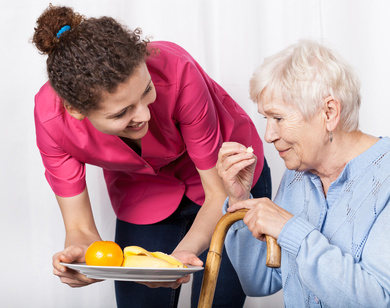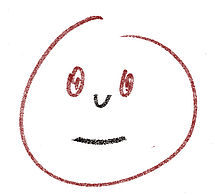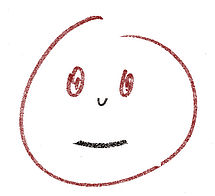Smell and taste in old age: the more independent the better
please scroll down for the longer version - download document - video interview
A team headed by Claire Sulmont-Rossé from the National Institute for Agricultural Research (INRA*) in Dijon, France, a member of the European Sensory Network (ESN), investigated the sense of smell and taste of 559 people between the ages of 65 and 99. The good news: in almost one-half of the cases, both senses functioned as well as ever. However, in 57% of those tested, either the sense of smell or taste, and in some cases both senses, were impaired. This can lead to a decline in appetite and meal enjoyment. Consequently, to help prevent the onset of malnutrition and malnourishment, there is a need for developing food products that fit to the sensory capacities of the elderly.

Some elderly can retain a good sense of smell and taste until old age
The findings were obtained within the framework of the AUPALESENS project (AUPALESENS: Improving the pleasure of elderly people for better aging and a fight against malnutrition). Funded by the French government, the objective of this project was to develop sensory strategies for improving food intake in senior citizens at risk of malnutrition.
The research team discovered that the impairment of the ability to smell and taste does not merely reflect an effect of age; it is also related to events that are associated with aging, such as the onset of disease, medications, and the decline in cognitive abilities. Furthermore, scientists have proven that the senses of smell and taste change independently of one-another. It appears that the two sensory systems are subject to separate modification processes.
The results of the current study afford a better understanding of sensory perception in the elderly. Claire Sulmont-Rossé proposes that, "This knowledge can be used by both the food industry and operators of homes for the aged; by concentrating on developing foods with pleasing texture and appearance, it should be possible for even those people with impaired sensory abilities to enjoy healthy meals."
Source
Evidence for different patterns of chemosensory alterations in the elderly population: impact of age versus dependency. Sulmont-Rossé C et al. Chem Senses. 2015 Mar;40(3):153-64. doi: 10.1093/chemse/bju112.
* Centre des Sciences du Goût et de l'Alimenation – INRA, CNRS, University of Burgundy (http://www2.dijon.inra.fr/csga/index.php)
Additional links:
INRA: www.dijon.inra.fr/en
European Sensory Network (ESN): http://www.esn-network.com
Long version
Smell and taste in old age: the more independent the better
A team headed by Claire Sulmont-Rossé from the National Institute for Agricultural Research (INRA*) in Dijon, France, a member of the European Sensory Network (ESN), investigated the sense of smell and taste of 559 people between the ages of 65 and 99. The good news: in almost one-half of the cases, both senses functioned as well as ever. However, in 57% of those tested, either the sense of smell or taste, and in some cases both senses, were impaired. This can lead to a decline in appetite and meal enjoyment. Consequently, to help prevent the onset of malnutrition and malnourishment, there is a need for developing food products that fit to the sensory capacities of the elderly.

Some elderly can retain a good sense of smell and taste until old age
In order to ensure that the elderly receive a healthy diet that is also appealing, it is important to understand the changes in their perceptions of smell and taste. Claire Sulmont-Rossé and team have put the sensory abilities of the elderly under the magnifying glass. Their research is a part of the French government-funded AUPALESENS project, whose goal is the development of sensory strategies for improving meal enjoyment and food intake in senior citizens at risk of malnutrition.
large individual differences
Studies over the last 25 years have shown that the sense of smell, and to a lesser extent the sense of taste, decline in the elderly. However, the overall effect of age on chemosensory abilities hides a large variability in the elderly population.
Do the senses of taste and smell decrease to the same extent? Which aspects of odor perception are especially affected in the elderly? Which aspects are dependent on the person’s age?
the test series: comprehensive but not too demanding
To answer these questions, Claire Sulmont-Rossé and her team invited 559 volunteers between the ages of 65 and 99 from four separate regions of France. The seniors participated in a series of tests that explored various aspects of their sense of smell and taste. They also answered questions concerning their living situation. Sulmont-Rossé declared, "We didn’t just want to single out a particular olfactory capacity, such as the odor threshold; we wanted to obtain an overall picture of the sense of smell. For this we used tests that showed how well a participant could perceive, differentiate, and categorize the smells. It is quite possible that specific aging processes govern these various olfactory abilities differently."
By using a set of chemosensory tests, the researchers assessed the ability of the participants to detect odors at a small concentration, to discriminate between different odor qualities (for instance, discriminate between a beef odor and a fish odor) and to determine whether an odor is a food odor (strawberry, caramel) or a non-food odor (rose, perfume). Finally, the researchers used rising concentrations of salt solutions to determine the participants’ thresholds in perceiving and identifying the taste of salt, which is acknowledged to be more affected by aging than the other tastes. "The seniors enjoyed the experience. None of them found the tests too tiring," stated Claire Sulmont-Rossé.
four groups discovered
"We were somewhat surprised by the results," says Claire Sulmont-Rossé. "With 40 percent of the seniors the sense of smell and taste was only very slightly impaired." In their analysis, the researchers detected four different sensory clusters:
43%
Cluster 1: good sense of smell and taste (well-preserved chemosensory abilities)
43% of the seniors had a well-preserved sense of smell and taste. However, with the exception of salt detection, they did not do as well as a parallel group of 63 participants with a mean age of 28.
33% 
Cluster 2: good sense of sense of smell but heavily impaired sense of taste (strong gustatory impairment)
33% of the participants had a well-preserved sense of smell, but had lost a high degree of their sense of taste.
21% 
Cluster 3: impaired sense of smell and taste (chemosensory impaired)
21% of the participants showed moderate smell and taste impairment. Their sense of taste was still better than that of group 2.
3% 
Cluster 4: strongly impaired sense of smell
Only three percent of the test subjects had lost most of their sense of smell and were unable to differentiate and categorize the various smells. Nevertheless their sense of taste was less impaired than in cluster 2.
In general, the participants in cluster 1 were younger, did not take medication that would affect their sense of smell and taste, and were able to take care of their daily needs without help. Participants in clusters 3 and 4 were older as a rule, took medication that affected their sense of smell and taste, and needed help, either in their own homes, or as residents of a facility for the aged. In terms of measured variables, cluster 2 did not stand out from the other clusters.
the elderly did not suffer chemosensory loss per se
As expected, the research team found a correlation between the results of the various smell tests as well as a correlation between the results of the taste tests. However, the scientists did not find a correlation between the scores of the smell and taste tests. This suggests that the two sensory systems are affected by the aging process independently from one another.
Why do the senses of smell and taste function separately from one another? Possibly each system reacts independently to the aging process and such environmental influences as pollution. Claire Sulmont explains that, "The olfactory neurons are in direct contact with the external environment. Thus they are more likely to be influenced by aggressive environmental factors than are gustatory cells."
food products conform to the target groups
Several physiological processes, such as drying of the olfactory mucosa, decrease in saliva flow, and reduction in the number of sensory receptors, have been reported to play a role in the decline of sensory perception. However, results of the study strengthen the hypothesis that the diminishing of chemosensory abilities is not only caused by classic processes of physical aging; rather, the events that usually accompany aging play a major role.
Health problems, dental disease, and the use of particular types of medication can be contributing factors. Claire Sulmont-Rossé states that, "It appears that age per se influences the perception of low intensity odor and taste stimuli. However, factors associated with a senior’s health status seem to have a negative influence on a senior’s ability to perceive even high intensity chemosensory stimuli."
How might the food industry and the institutions that care for the elderly benefit from these findings? "To be sure that people of every age group will enjoy their food, the key-drivers for food choices should be ascertained in conjunction with the chemosensory abilities of the consumer," Clair Sulmont-Rossé emphasized. "For instance, the visual aspects and texture of food could be modified so that people with a diminished sense of smell could have more enjoyment eating."
Source:
Evidence for different patterns of chemosensory alterations in the elderly population: impact of age versus dependency. Sulmont-Rossé C et al. Chem Senses. 2015 Mar;40(3):153-64. doi: 10.1093/chemse/bju112.
* Centre des Sciences du Goût et de l'Alimenation – INRA, CNRS, University of Burgundy (http://www2.dijon.inra.fr/csga/index.php)
Additional Links:
INRA: www.dijon.inra.fr/en
European Sensory Network (ESN): www.esn-network.com
Photo: Photographee.eu - Fotolia.com
Graphic: Fabienne Hübener